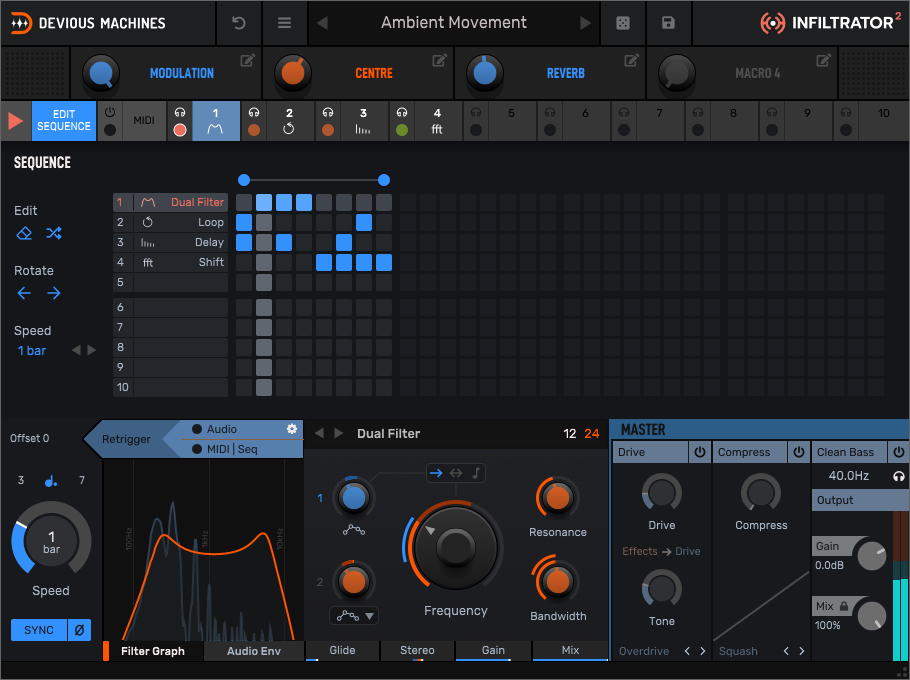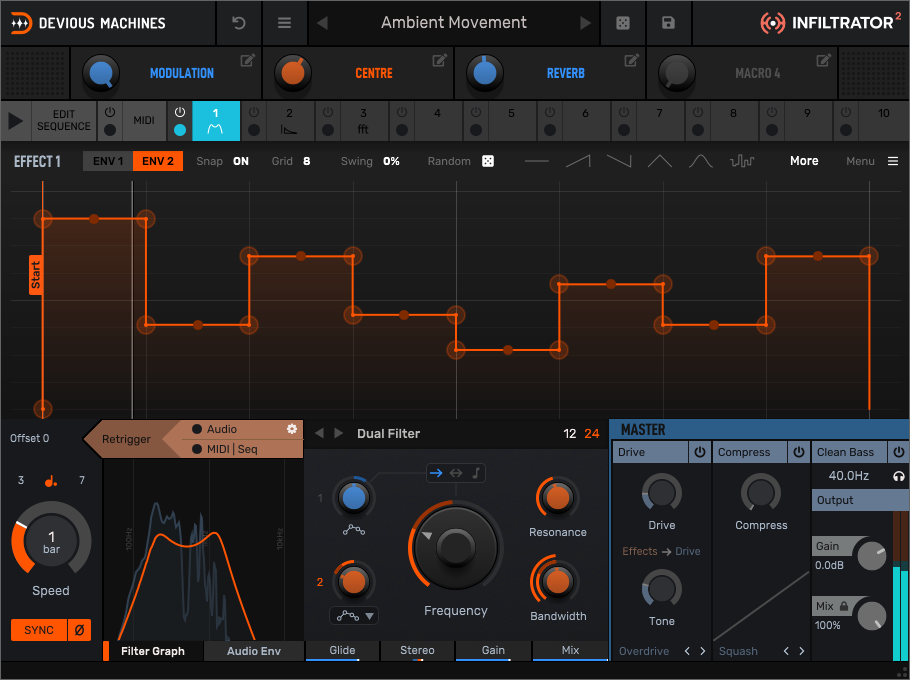DAW
Devious Machines INFILTRATOR 2 – the Synth and Software Review
If Jim Aikin says it’s ridiculously cool, it’s a safe bet that it is
Making earworm beats just got a whole lot easier. Whether you want to crush your listeners with jaw-dropping rhythmic effects or just filter a messy snare hit on beat 4 of every other bar, Infiltrator 2 is the tool for the job.
The concept seems simple enough, until you start to dig into it and see just how deep it is. Infiltrator has a generous ten slots into each of which you can insert any of its 54 different effects algorithms. Each slot features a syncable, looping multisegment envelope that can be used for modulating the effect’s parameters in various rhythm-based ways. An envelope follower on the input audio is also available as a modulation source, so your effects can respond to the drum hits in natural (or unnatural) ways.
At a higher level there’s a 32-step sequencer that will switch each effect slot on or off (bypassed) at each step. If you want distortion on beat 3, a comb filter on beat 5, and reversed audio on beats 2 and 6, setting it up is super-easy. There are also four assignable macro knobs and a few other niceties.
According to Devious Machines, Infiltrator ships with 1,500 presets. (I didn’t count them all.) The level of creative sound design in the preset bank is mind-boggling, and that’s before you start making a few edits. The obvious application for Infiltrator is processing percussion tracks, but it works just as well on pads, bass, or guitar riffs. Try it on anything!
Infiltrator is a VST2/3, AU, and AAX plugin. There’s a downloadable demo that emits white noise hiss every minute or so. If you have any experience with modern music software, I think you’ll find the user interface very easy to understand. Things that ought to work, such as double-clicking a knob to return it to its default value, work as expected. I only had to check the manual a couple of times.
Not to keep you in suspense, I spotted a couple of significant omissions from the feature set. First, the effects are always connected in series. In the current version there is no option for parallel signal routing. This is probably not a big deal, as you can always split your dry audio and send it through two Infiltrators in parallel. Second, there’s no sidechain input, so sidechain compression is not possible. For the same reason, the vocoder effect is of limited value, because the carrier signal will always be the internal oscillator, which is frankly not very interesting.
Also, because you may be wondering, Infiltrator does not host 3rd-party plugins. It just uses its own effects algorithms.
The effects. The heart of any FX plugin is the choice of effect types. Infiltrator’s menu includes 15 filter types, plus some basic EQ for tone control; a few utilities such as panning and noise gate; 14 fft (Fast Fourier Transform) effects of various kinds; and 17 more general types such as reverb, delay, a phaser, pitch slow-down, and so on. It may seem odd that there’s no chorus or flanger, but these effects are based on delays, and you’ll find some presets that produce the desired effect using the delay module.
The available parameters for a given effect are basic, not fancy. No more than three parameter knobs are in the main control panel, plus a couple of knobs for modulation depth. With some effects, such as the notch filter, you only get one active parameter knob (the notch frequency).
There are also slider widgets along the bottom of the effect panel, which provide control of the gain, wet/dry mix, stereo spread, and glide time of each effect. Glide time smooths out the rapid transitions in either the multisegment envelope or the input audio envelope follower. Some effects replace one of this latter set with a special parameter, such as ping-pong for the delay and pre-delay for the reverb.
Did I say there are 15 filters? In fact it’s more like 40. Resonant, of course. There are four different filter models, each with lowpass, bandpass, and highpass types, and within each of those you have a choice of rolloff slopes, which may range from 6 to 36dB per octave. There’s also a notch filter, a dual lowpass, and a formant filter.
The fft spectrum-altering effects can add a bit of color or warp the signal into something completely unrecognizable. For these effects you’ll want your DAW to have delay compensation enabled, as the processing takes a few milliseconds. Data processing sizes from 256 to 4096 samples (in power-of-2 increments) are supported. The fft types include shift, mirror, scatter, rotate, cascade, twist, and other things.
When you start combining two or more of the effects, the number of possibilities is astronomical. Some effects will be more useful for specific types of tracks, but I’m not going to try to provide a catalog of the possibilities. It would take months to write it, and even then it would be woefully incomplete. I had a lot of fun processing a stock drum loop in Reason to add crunch, ratchet, phaser, reverse, and other effects in various combinations.
Synchronized modulation. Each effect in the signal chain has its own multisegment envelope, as already mentioned. This can be used to modulate any of the parameters in that effect. There’s no modulation matrix for routing the envelope from one effect to the parameters of another, but that’s not likely to pose much of a problem. Maybe in version 3 they’ll add that.
The envelope can and usually will loop, either in sync with your DAW’s transport or freely. By default, the setting is for the loop to increment in standard rhythmic values — eighth-note, quarter-note, half-note, and so on — but you can set it up to do triplets, dotted rhythm values, or odd lengths such as 7/8. Alternatively, you can turn off sync so the envelope loops freely, or set it to be retriggered by the audio input or the start of the effect in a multi-step sequence. Full marks for flexibility.
When editing the envelope, you can turn snap-to-grid on or off, change the curvature of a given segment, add shorter pulses within a single segment, click the random button to see what you get, and so on. One of the options is for a stepped envelope with horizontal and vertical segments. If you have a shape that you like but it doesn’t start where you want it to start in the bar, just drag the Start marker to the right; problem solved. A swing amount parameter will pull some of the envelope breakpoints to the right.
The envelopes can be transmitted from the plugin in the form of MIDI CC data, but this feature is DAW-dependent. Not all DAWs support MIDI output from plugin effects.
Step sequencer. The step sequencer controls whether each effect is turned on or off at a given time. The length of individual steps is variable from a 32nd-note to 16 bars. There are no odd-length step times here; the assumption here is that your music is probably in 4/4, which is not really a bad assumption.
When processing a drum loop you might reasonably set the step length to quarter-notes, which will cause a new set of effects to leap into action on every quarter-note. This setup makes things like doing a tape-stop effect or a ratcheting fill at the end of a two-bar or four-bar phrase extremely easy to set up. My only concern about this setup is that when the reverb effect shuts off, the reverberating tail stops abruptly. I’d very much like to see an option in which the input of the reverb shuts off while the tail continues to sound.
Instead of using the sequencer, you can switch individual effects on and off using MIDI notes from your DAW. Again, this feature depends on the features of your DAW, as not all of them will route MIDI tracks to an effect plugin.
Macro knobs. The four macro knobs can control any combination of parameters in any effect. For instance, you could control the wet/dry mix of one effect, the resonance of a filter in a different effect, and the delay feedback in a third effect, all from a single knob. Automating the macro knobs from your DAW should be possible in just about every DAW, but there’s no facility for moving the macro knobs internally within Infiltrator, other than turning them by hand with the mouse. The macro knobs can’t be used to change the behavior of the step sequencer, but there’s probably no need to do that.
Other features. A global drive effect can be positioned either before or after the effects chain, and there’s a compressor on the output. Each of these gives you several choices for the type of algorithm the global effect will employ. A switch and an adjustable frequency value can be used to let the low frequencies pass through unaffected, which is handy for drum processing when you want the kick to come through.
Save As… The obvious use of Infiltrator is for making beats in the grand old tradition of hip-hop, but it will do a lot more than that. You can add a subtle rhythmic pulse to a pad track, drop some stuttering onto a vocal, or add a buzzy reverse to the last beat of a bass riff. Sometimes I got great results just by grabbing a random effect and twisting a few dials, but other times some experimentation was needed in order to get something that sounded good. Infiltrator invites you to experiment, and that’s one of its great strengths. The sheer number of effect types and the extremely flexible looping envelopes are also brilliant.
Yes, you could do similar types of looping by automating other effects plugins, but Infiltrator will set you up much, much more quickly and conveniently. I’d recommend Infiltrator to almost anybody who is producing tracks and mixes.

















